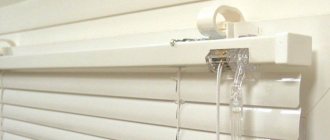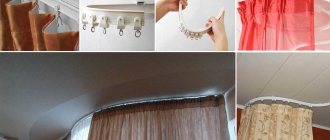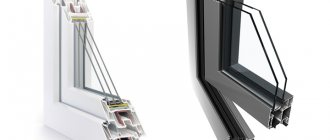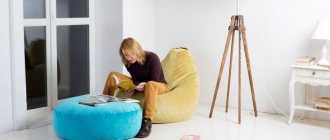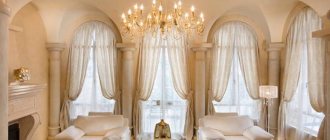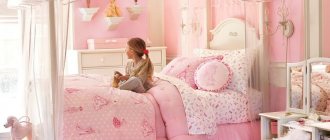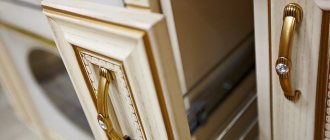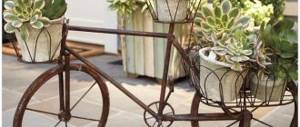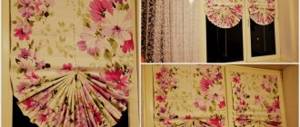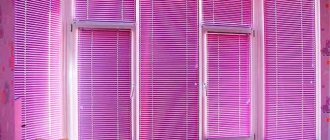Blinds - this element of the interior has long gone beyond office premises. Thanks to the huge selection of designs and materials for making blinds, they fit perfectly into any interior, adding the necessary notes to the textures of the room. Modern blinds can become a key element that sets the desired style for the interior. But to create the desired effect, you will have to go through a difficult path.
Basic tips for choosing blinds
Advice: Do not choose blinds without the recommendations of specialists with extensive experience in installing them.
In order not to regret choosing blinds in the future, you need to accurately determine the following positions:
- type of construction, direction of the lamellas and sides in which they will move;
- option for controlling blinds, it is important to consider the availability of the control mechanism.
- material and texture;
- mounting option and corresponding dimensions;
- color and design;
- compliance with the overall interior of the room
Depending on the initial data, the approach to choosing blinds also varies.
Recommendations for choosing blinds for plastic windows
Not all designs and mounting options for blinds are suitable for plastic windows. For example, the option with vertical blinds installed close to the glass is not possible.
We invite you to read the article about installing vertical blinds on a plastic window, it describes installation methods and provides video recommendations for installing blinds on a plastic window
You know what a comb for plastic windows is and what it is used for. The answer can be found - https://oknanagoda.com/okna/plastik/furnitura/grebenka-dlya-plastikovykh-okon-ustano.html
To make the slopes look beautiful, finish them. Working with slopes of plastic windows outside and inside find out more information
The most popular option for plastic windows would be horizontal blinds located inside the double-glazed window. The second place in popularity is occupied by roller blinds, especially with special guides that guarantee the proximity of the fabric to the glass, and therefore good protection from the sun. Cassette blinds are a universal option for windows with non-standard opening methods or, for example, attics. Pleated blinds are also suitable for plastic structures. Their main advantage in this case is lightness.
Choosing blinds for wooden windows
In the case of wooden frames, there are probably no special recommendations for choosing the design of blinds. All those options that are preferable for plastic windows are also suitable for wooden windows.
Aesthetics are more important here. Owners of wooden windows should think about maintaining environmental themes in the interior and choose wooden or bamboo blinds. If you follow the general principles of decor, then in rooms with high ceilings you can hang horizontal blinds, but in order to visually raise the ceiling, it is better to resort to vertical structures.
Tips for choosing blinds for loggias and balconies
Obviously, you will have to abandon blinds mounted on the window sash if the balcony is glazed using aluminum frames.
Also, vertical blinds are of little use for loggias - the ceiling design on the balcony rarely allows you to attach anything to it, and the space is not large, why hide it with bulky blinds.
The material of the blinds must be weather-resistant and easy to clean.
Accordingly, compact roller blinds and cassette blinds mounted directly on the shutters will be optimal. If the selection process is successfully completed, the most critical stage begins. Mistakes at this stage most often lead to disastrous results.
Types of blinds designs
There are three types of blinds designs: horizontal, vertical and roller blinds. The first ones are the most universal, they are used everywhere. The second ones, as a rule, are purchased for offices and institutions, while the third ones are intended for home use or more specific tasks. Let us examine in more detail the features of each design.
So, vertical blinds consist of the following elements:
- narrow or wide lamellas - strips, the width of which is 87-127 mm, and the length - depending on the height of the window;
- a metal or plastic cornice that ensures the reliability of the structure - it is best to choose aluminum frames, as they will last longer;
- weights - due to them, the lamellas hang strictly vertically. As a rule, they are made of plastic or metal. Plastic is better because it does not corrode;
- runners - elements that ensure the movement of lamellas along the cornice;
- chain for connecting the lamellas at the bottom;
- a chain that controls the movement of the blinds and their position.
Read more about vertical blinds.
Horizontal blinds are the most reliable. They provide the best protection from the sun, are easy to install, and easy to operate. Plus, it's a classic. These blinds do not take up space and can be mounted directly into the window opening. As a rule, they are used in kitchens, office spaces, even bedrooms. In addition to classic horizontal blinds, one should distinguish between attic and interframe blinds. The first ones are attached not only at the top, but also at the bottom to the roof window, installed at an angle so as not to sag. The latter are distinguished by the fact that they are built between the double-glazed window frames, and their control is brought outside. Therefore, they take up almost no space.
A detailed article about the types of horizontal blinds.
Roller blinds consist of a shaft and fabric wound around it. When fully unwound, it covers the entire window, dramatically reducing the amount of light in the room to the point of darkness. To prevent the fabric from deteriorating from constant exposure to the sun, it is treated with impregnation.
Which roller blinds to choose for plastic windows?
An interesting option is pleated blinds. This is the same fabric, but it is tucked into a special device. Thanks to it, the fabric gathers into folds of the desired shape and retains its appearance for a long time. The material used for pleating is polyester, which is treated with impregnation to make it resistant to ultraviolet radiation. In addition, it allows the material to be resistant to fire. Pleated fabrics, like fabrics, have many textures and shades. These canvases can be transparent or not transmit sunlight at all, etc.
Types of finishing of internal window slopes
The last type of blinds is a combined design. It is also called “day-night”, since it alternates elements with different light transmittance. Depending on your needs, you can adjust the flow of light into the room in several movements. These blinds are an ideal solution for windows facing the sunny side.
Horizontal blinds
Horizontal blinds are horizontal strips attached to a cornice, connected to each other using a cord.
Related article: Primer before putting drywall - a necessity or a whim of designers
Materials for production:
- Aluminum strips in a wide range of colors, widths 16, 25, 35 mm.
They have a long service life, are covered with automotive-type paint, do not fade or break. If the strip is bent, a mark will remain at the bend. Operating instructions for blinds - Artificial materials made to look like wood, lamella width 25, 50 mm. They are cheaper than natural materials, imitate wood with high quality, and it is easy to choose a model and color to match the design of the room.
- Natural materials: wood, bamboo give the interior of the room additional comfort. Ideal for decorating rooms in a classic style. For production, strip widths of 25 and 50 mm are used with shades of natural wood. They are quite expensive due to the need to process the material to give it durability and strength.
- Plastic models are used in public places, have a low cost, but fade and break when exposed to direct sunlight.
When installing horizontal blinds on a flap, purchase a lower fixation; it will prevent the product from sagging when the window is opened for ventilation.
The products are attached to the window using two metal brackets; if necessary, the cornice can be easily removed from the fastenings.
Blinds are made to individual sizes and designs, and photo printing can be ordered. Plastic models are sold ready-made and are available in the most popular sizes.
Rules for controlling horizontal blinds
In order for a product to serve for a long time, you need to manage it correctly:
- the degree of light transmission is adjusted by changing the angle of rotation of the lamellas by turning the cane;
- to raise the canvas, pull the rope down, and lower it by pulling the rope up;
- To fix it at the required height, we move the rope away from the middle of the canvas and release it.
Before raising/lowering the canvas, it is necessary to rotate the strips to a horizontal position relative to the floor.
Vertical blinds - longitudinal strips
In terms of ease of control, vertical blinds are ahead of their horizontal counterparts. And in design, too, perhaps.
Plastic or fabric are used to make them, but it would not be entirely correct to say so. The fact is that the texture of the fabric can be chosen in the range from a lace curtain to a light-proof curtain, and the plastic can be from almost completely transparent to having the most bizarre texture. All this allows us to talk about dozens of materials used for vertical blinds.
Main advantages
If we compare vertical blinds with horizontal ones, we can note that they look much more comfortable, but at the same time retain all the functional amenities.
- The luminous flux can also be adjusted smoothly and within approximately the same range.
- Full opening of vertical blinds looks like the usual window drapes: from one edge to the other or to the edges from the center.
- The effort required to move them is much less due to their vertical location.
- The mechanism experiences little stress and lasts longer.
Thanks to their advantages, vertical blinds have taken their rightful place in offices, shops and public buildings. They are increasingly found in apartments. The reasons for this are the price, comparable to curtains, convenient control of room lighting and a huge selection of types of fabrics and materials to suit any interior.
There are also environmental benefits. Thanks to the dust-repellent treatment and antistatic coating, the blinds are suitable for rooms with increased requirements for sanitary conditions.
Interior designers are forced to take into account the undoubted functional advantages of vertical blinds when searching for a combination with classic types of window drapery. Options are in demand when heavy curtains are used in conjunction with light fabric blinds or air curtains with blinds that provide complete protection from the sun.
Unobvious advantages of vertical blinds:
- use in fire hazardous areas;
- the ability to design inclined structures;
- variety of management types.
Materials
The slats of vertical blinds are made from the following fabrics and materials:
Non-woven fabric is the most economical option. The disadvantages of this fabric include its relative fragility, as well as its incompatibility with staying in rooms with humid or polluted air.
Woven fabric is the undoubted “bestseller” in the blinds family. The undoubted advantages include:
- dust-repellent water-repellent impregnation;
- can be dry and wet cleaned;
- increased service life without loss of consumer properties and appearance;
- Thanks to transparency, they create the effect of light scattering.
Jacquard is a polyester fabric with an woven relief pattern. Intricate patterns of threads of different thicknesses create a sophisticated appearance and are equally suitable for both apartments and offices.
Fiberglass fabric is ideal for use in areas where fire safety requirements must be met. It does not emit smoke or harmful substances, does not burn, but only bakes. Fiberglass blinds do not require special care and retain their appearance for a long time.
Decorative wave is an unusual fabric with a “silhouette”. Smoothly curving lines go well with classic curtains and create a romantic atmosphere.
Plastic blinds provide excellent protection from direct sunlight, are quite elegant, and most importantly, meet high hygienic standards:
- do not absorb grease and dirt;
- easy to clean even with the use of disinfectants;
- do not accumulate electricity.
The hygiene of plastic blinds makes it possible to use them in medical institutions and pharmacies.
Aluminum blinds are made from strips 89 mm wide. The aluminum used is special and environmentally friendly. Usually they have a special texture, are reliable and unpretentious to external conditions.
Design solutions
Multi-texture is another type of vertical blinds, including:
- combination of several materials;
- imitation of lambrequins and curtains;
- independently controlled lambrequins.
The technology of multi-texture blinds allows you to combine different types of fabric and plastic within a single composition and obtain original design solutions in accordance with customer requests.
Multi-texture blinds can often be found in public spaces:
- in sales showrooms,
- in clubs,
- in bars and restaurants.
In public places:
- in executive offices,
- in meeting rooms.
At relatively low costs, using multi-textured blinds you can decorate your interior extremely effectively.
Peculiarity of perception
According to the observations of PROMA company specialists, the popularity of multi-textured blinds can vary greatly depending on the region. In a number of constituent entities of the Russian Federation, they are readily purchased both for home and office. In others, sales are almost completely absent. This ambiguity is caused by cultural traditions. Buyers are attracted by their originality and brightness of design solutions, while other people are repulsed by pretentiousness and “excessiveness”. But in general, multi-texture blinds can be called popular in Russia. Combinations of fabric and plastic, various shades and gold or silver inserts and even mirrors allow you to design original lambrequins of any shape according to individual sketches.
Types of multi-texture blinds
- Cascade
- Garland
- Diamond
- Cascade border
- Blinds with picture
- Combination
- One of the most common types of multi-texture blinds is the “cascade”. It looks modern and gives the window a laconic look.
- Many could see the “Garland” in living rooms and dining rooms. In appearance, this type of blinds resembles ancient curtains, if they are made in a new modern version.
- Another type of multi-texture diamond blinds. The essence of this design method is to add slats of a different texture and color to ordinary plastic blinds. As a rule, the number of such inserts is 11–12. “Diamond” looks good in fairly large rooms from 100 sq. m: rest rooms, meeting rooms.
- A design method using multi-textured blinds called “cascading border” is gaining popularity. On large windows, a gold or silver border looks bright and contrasting.
- Vertical blinds with an image printed on them look no less impressive. They look especially appropriate in beauty salons and sports clubs. The image can be an advertisement. A message or branding applied to the street-facing surface of the blinds turns them into an information display.
- Various combinations of multi-textured diamond blinds with printed patterns look unusual and attractive. Well suited for cinema halls, game rooms and billiard rooms.
